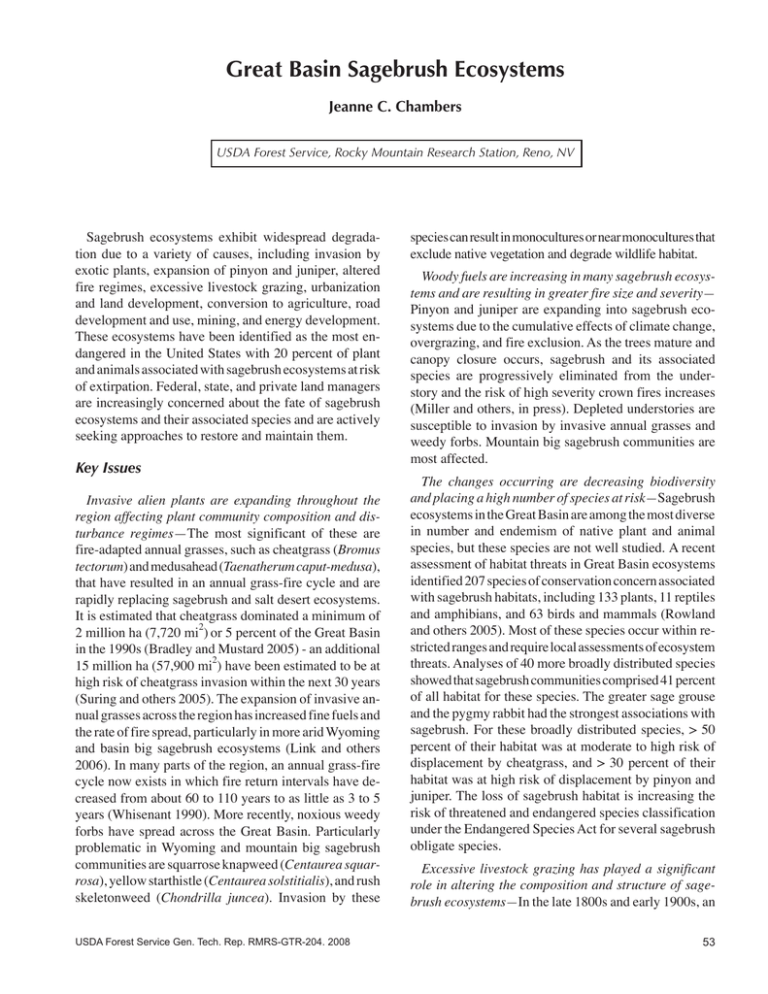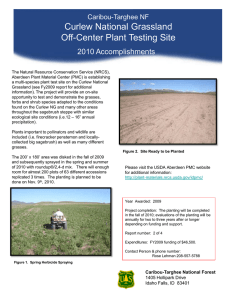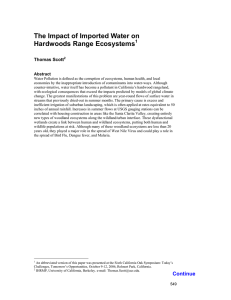Great Basin Sagebrush Ecosystems Jeanne C. Chambers
advertisement

Great Basin Sagebrush Ecosystems Jeanne C. Chambers USDA Forest Service, Rocky Mountain Research Station, Reno, NV Sagebrush ecosystems exhibit widespread degradation due to a variety of causes, including invasion by exotic plants, expansion of pinyon and juniper, altered fire regimes, excessive livestock grazing, urbanization and land development, conversion to agriculture, road development and use, mining, and energy development. These ecosystems have been identified as the most endangered in the United States with 20 percent of plant and animals associated with sagebrush ecosystems at risk of extirpation. Federal, state, and private land managers are increasingly concerned about the fate of sagebrush ecosystems and their associated species and are actively seeking approaches to restore and maintain them. Key Issues Invasive alien plants are expanding throughout the region affecting plant community composition and disturbance regimes—The most significant of these are fire-adapted annual grasses, such as cheatgrass (Bromus tectorum) and medusahead (Taenatherum caput-medusa), that have resulted in an annual grass-fire cycle and are rapidly replacing sagebrush and salt desert ecosystems. It is estimated that cheatgrass dominated a minimum of 2 million ha (7,720 mi2) or 5 percent of the Great Basin in the 1990s (Bradley and Mustard 2005) - an additional 15 million ha (57,900 mi2) have been estimated to be at high risk of cheatgrass invasion within the next 30 years (Suring and others 2005). The expansion of invasive annual grasses across the region has increased fine fuels and the rate of fire spread, particularly in more arid Wyoming and basin big sagebrush ecosystems (Link and others 2006). In many parts of the region, an annual grass-fire cycle now exists in which fire return intervals have decreased from about 60 to 110 years to as little as 3 to 5 years (Whisenant 1990). More recently, noxious weedy forbs have spread across the Great Basin. Particularly problematic in Wyoming and mountain big sagebrush communities are squarrose knapweed (Centaurea squarrosa), yellow starthistle (Centaurea solstitialis), and rush skeletonweed (Chondrilla juncea). Invasion by these USDA Forest Service Gen. Tech. Rep. RMRS-GTR-204. 2008 s­ pecies can result in monocultures or near monocultures that exclude native vegetation and degrade wildlife habitat. Woody fuels are increasing in many sagebrush ecosystems and are resulting in greater fire size and severity— Pinyon and juniper are expanding into sagebrush ecosystems due to the cumulative effects of climate change, overgrazing, and fire exclusion. As the trees mature and canopy closure occurs, sagebrush and its associated species are progressively eliminated from the understory and the risk of high severity crown fires increases (Miller and others, in press). Depleted understories are susceptible to invasion by invasive annual grasses and weedy forbs. Mountain big sagebrush communities are most affected. The changes occurring are decreasing biodiversity and placing a high number of species at risk—Sagebrush ecosystems in the Great Basin are among the most diverse in number and endemism of native plant and animal species, but these species are not well studied. A recent assessment of habitat threats in Great Basin ecosystems identified 207 species of conservation concern associated with sagebrush habitats, including 133 plants, 11 reptiles and amphibians, and 63 birds and mammals (Rowland and others 2005). Most of these species occur within restricted ranges and require local assessments of ecosystem threats. Analyses of 40 more broadly distributed species showed that sagebrush communities comprised 41 percent of all habitat for these species. The greater sage grouse and the pygmy rabbit had the strongest associations with sagebrush. For these broadly distributed species, > 50 percent of their habitat was at moderate to high risk of displacement by cheatgrass, and > 30 percent of their habitat was at high risk of displacement by pinyon and juniper. The loss of sagebrush habitat is increasing the risk of threatened and endangered species classification under the Endangered Species Act for several sagebrush obligate species. Excessive livestock grazing has played a significant role in altering the composition and structure of sagebrush ecosystems—In the late 1800s and early 1900s, an 53 estimated 26 million cattle and 20 million sheep were grazing on western rangelands (Wilkenson 1992). Excessive or inappropriate grazing and little or no management caused major changes in plant communities in less than 10 to 15 years (Hull 1976). By the 1930s, grazing capacity had declined 60 to 90 percent from historical levels (McArdle 1936). In the 1940s and 1950s, animal numbers were 50 to 60 percent less than in the early 1900s and by the 1990s, were about 40 percent. In the Great Basin, excessive or inappropriate grazing has altered the relative proportions of shrubs, grasses, and forbs, increased opportunities for invasion and dominance of non-native grasses and forbs and, in some cases, caused an overall decline in site potential through loss of topsoil (Miller and Eddleman 2001). Declines in site condition often decrease the ability of soils to capture, store, and release water causing sites to become more arid and less productive. Excessive or inappropriate grazing also increases the potential of direct competition and interference with sagebrush obligate species such as sage grouse and pygmy rabbits. Land rehabilitation/restoration treatments have ­affected large areas of the Great Basin—Due to rangeland deterioration and watershed problems, such as flooding and erosion, reseeding programs that focused on pasture grasses were initiated on Forest Reserves in the early 1900s (Monsen 2005). In the late 1940s, widespread mechanical and chemical control of vegetation was initiated and by the mid-1990s, close to 1.2 million ha (4.9 million acres) had been treated on BLM lands alone (Miller and Eddleman 2001). Areas that had already lost most of the native grasses and forbs were plowed or chained and seeded to crested wheatgrass (Agropyron desertorum, A. cristatum, and A. sibericum). Many are now dominated by sagebrush with a crested wheatgrass understory. Communities with plant understories still in relatively good condition were often burned or sprayed with phenoxy herbicides (for example, 2, 4-D) to reduce sagebrush and increase native grasses. Areas with pinyon and juniper trees were typically chained and then seeded with crested wheatgrass and other introduced grasses. Recently, the focus of these efforts has been on restoring wildlife habitat and reducing fuel loads with fire and mechanical treatments. Although many of the same techniques are still used, there is greater emphasis on restoring native ecosystems and seeding native species although seed supplies limit these efforts (Shaw and others 2005). It is difficult to restore depleted understories, especially in areas where exotic annual grasses have invaded. 54 Climate change is evident already in sagebrush ecosystems and future changes are likely to be greater— Temperatures increased 0.3 to 0.6 °C (0.6 ° to 1.1 °F) in the last 100 years, and are expected to increase another 2 to 5 °C (3.6 to 9 °F) in the next 100 years. Snowmelt is occurring 10 to 15 days earlier than in the mid-1900s at most monitoring sites in the Great Basin and growing seasons have been similarly extended. As temperatures increase, species shifts are likely to occur. Increased temperatures have already extended the fire season with more fires occurring earlier and later than in the past and, in some areas, the total area burned has increased (McKenzie and others 2004). If climate change increases the amplitude and duration of extreme fire weather, larger and more severe fires are likely. Various pests and insect outbreaks could increase under several different warming scenarios. Projected changes in precipitation are inconsistent as to sign, and the average changes are near zero (Cubashi and others 2001). The effectiveness of future precipitation will depend on the actual increase in precipitation relative to the degree of warming and its effects on snowmelt and evapotranspiration. Human population growth and changes in land use— The human population in the Great Basin is growing at one of the highest rates in the nation. Much of this growth is occurring around urban population centers such as Salt Lake City, Reno, and Las Vegas, but the effects are widespread. Development in the wildland/ urban interface and construction of infrastructure to support the burgeoning population (energy developments like coal-fired power plants and transmission corridors, water extraction or diversion, and pipelines) is causing the loss of sagebrush habitat and placing species at risk. Increased access and use of wildland ecosystems near developments has increased fire starts (Keeley and others 1999). Roads and off-road vehicle and recreational use have increased the spread of invasive plant species across the region (Wisdom and others 2005). Management Challenges The Great Basin has been the focus of relatively few large-scale research and management programs and is one of the few ecoregions that does not have a Long-Term Ecological Research Site. Basic resource information collected at appropriate scales is needed to evaluate alternative management options in the future and develop new and effect management strategies. Ground monitoring, remote sensing, GIS, and modeling platforms are needed to support these efforts. USDA Forest Service Gen. Tech. Rep. RMRS-GTR-204. 2008 Methods are needed for assessing current ecological conditions and species status across the region—Information on the current ecological status (intact, at risk, threshold crossed) of sagebrush ecosystems and on the status of individual species is necessary for developing strategic plans and implementing management and restoration programs. Methods are needed for monitoring the types and rates of change occurring in sagebrush ecosystems—Information on the changes in vegetation, soils, and animals, as well as in climate, fire regimes, and invasive species is needed for effective adaptive management. Methods/tools are needed for predicting future effects of ecosystem stressors on sagebrush ecosystems—Predictive information is needed on the future effects of increases in human populations, climate change, fire and invasives that can be used to develop alternative scenarios and guide research and management programs. Methods/tools are needed for prioritizing management activities and restoration treatments at site, watershed, and landscape scales—Prioritization requires information on the ecological status of sagebrush ecosystems and individual species, habitat and range requirements for species of concern, and abiotic and biotic conditions that cause irreversible changes in both plants and animal habitat. Methods/tools are needed for maintaining intact ecosystems, protecting ecosystems at risk, and restoring degraded ecosystems—Although many studies have been conducted on managing and restoring sagebrush ecosystems, information/tools are still lacking in several areas, including: 1) economic analysis tools to evaluate costs and benefits of alternative management strategies to both the resource and human populations, 2) seed supplies and establishment methods for native species; 3) methods for controlling invasive species while reestablishing sagebrush communities. Education programs are needed to build consensus for implementing necessary changes in management. Research and Management Questions There are still numerous research and management questions that remain to be answered about Great Basin ecosystems. What are the effects of pinyon-juniper expansion on watershed function and water resources? What are the effects of conversion to invasive annuals on watershed function and water resources? USDA Forest Service Gen. Tech. Rep. RMRS-GTR-204. 2008 How will climate change influence water resources in sagebrush ecosystems? How will climate change influence fire regimes and expansion of invasive species? What fire regimes are required to maintain the diverse sagebrush ecosystems of the Great Basin? What are the abiotic and biotic thresholds that determine the recovery capacity of the diverse sagebrush ecosystems following disturbance or management treatments, and how can these be defined? What are the effects of prescribed fire and fire surrogate treatments on watershed functioning and on the vegetation, soils, and animals that comprise sagebrush ecosystems? What are the factors that make sagebrush ecosystems susceptible/resistant to invasion by nonnative species? What are the rates of expansion of invasive plant species, types of activities that increase invasion rates, and types of ecosystems where expansion is occurring most rapidly? Can changes in current management activities be used to decrease the rates of invasion? What are the most appropriate scales and stages of invasion to target control activities? What are the longer-term impacts of using herbicides to control invasive species? What are the habitat requirements and spatial structures of populations, and what is the population biology of the endemic plant and animal species in the Great Basin? What are the cause-effect relationships between pervasive land uses and population responses of species at risk? How can we develop effective education/training programs for increasing public understanding management issues and building support for restoration projects? How can we develop effective education/training programs on new technologies/strategies for agency personnel? Strategic Plans Bureau of Land Management. National Sage-Grouse Habitat Conservation Strategy, U.S. Department of the Interior, November 2004. http://www.blm.gov/nhp/ spotlight/sage_grouse/docs/Sage-Grouse_Strategy.pdf [2007, July 17] 55 U.S. Geological Survey. Pike, D.A.; Pellant, M. 2002. Strategic Plan for the Coordinated Intermountain Restoration Project. USGS/BRD/ITR 2002-0011. Information and Technology Report. Research and Management Projects Intermountain Regional Observatory Network (IRON). The National Ecological Observatory Network (NEON). http://www.neoninc.org/ [2007, July 17] Integrated Weed Control and Restoration for the Great Basin Project. http://www.ag.unr.edu/ifafs/ [2007, July 17] The Nature Conservancy, Great Basin Regional Assessment Project, a compilation of the diversity, richness and status of native species, natural communities, and ecological systems present with the Great Basin Ecoregion. USDA Forest Service, Rocky Mountain Research Station. Great Basin Ecology Lab. http://www.ag.unr.edu/ gbem/ [2007, July 17] USDA Forest Service, Rocky Mountain Research Station. Shrub Sciences Lab. 30 Aug. 2006. http://www. fs.fed.us/rm/provo/ [2007, July 17] USDI Bureau of Land Management Great Basin Restoration Initiative. http://www.fire.blm.gov/gbri/ [2007, July 17] U.S. Geological Survey, Biological Resources Division and USDI Bureau of Land Management. SAGEMAP.12 June 2004. A GIS database for sage grouse and sage steppe management in the Intermountain West. http://sagemap. wr.usgs.gov [2007, July 17] U.S. Geological Survey, Forest and Rangeland Ecosystem Science Center, Coordinated Intermountain Restoration Project: 30 June 2003. http://fresc.usgs.gov/research/ StudyDetail.asp?Study_ID=305 [2007, July 17] References Bradley, B. A.; Mustard, J. F. 2005. Identifying land cover variability distinct from land cover change: cheatgrass in the Great Basin. Remote Sensing of Environment. 94: 204-213. Cubashi, U.; Meehl, G. A.; Boer, G. J. 2001. Projections of future climate change. Pages 525-582. In: Houghton, J. T., et al. eds. Climate Change 2001: The Scientific Basis. Contribution of the Working Group I to the Third Assessment Report of the Intergovernmental Panel on Climate Change. Cambridge University Press. 56 Hull, A. C., Jr. 1976. Rangeland use and management in the Mormon west. In: Symposium on Agriculture, Food and Man – Century of Progress. Provo, UT: Brigham Young University. Keeley, J. E.; Fotheringham C. J.; Morais M. 1999. Reexamining fire suppression impacts on brushland fire regimes. Science. 284: 1829-1832. Link, S. O.; Keeler, C. W.; Hill R. W.; Hagen, E. 2006. Bromus tectorum cover mapping and fire risk. International Journal of Wildland Fire. 15: 113-119. McArdle, R. F. 1936. The whiteman’s toll. In: Wallace, H. A. Letter from the Secretary of Agriculture to the U.S. Senate. A Report on the Western Range. A Great but Neglected Resource. Senate Document 199: 81-116. McKenzie, D.; Gedalof, Z. M.; Peterson, D. L.; Mote, P. 2004. Climate change, wildfire and conservation. Conservation Biology 18: 890-902. Miller, R. F.; Eddleman, L. L. 2001. Spatial and temporal changes of sage grouse habitat in the sagebrush biome. Corvallis, OR: Oregon State University, Agricultural Experiment Station Bulletin 151. Miller, R. F.; Tausch, R. J.; McArthur, D. E.; Johnson, D.; Sanderson, S. C. [In Press]. Development of Post-Settlement Piñon-Juniper Woodlands in the Intermountain West: A regional perspective. Gen. Tech Rep. RMRS-GTR-TBD. Fort Collins, CO: U.S. Department of Agriculture, Forest Service, Rocky Mountain Research Station. Monsen, S. B. 2005. History of range and wildlife habitat restoration in the Intermountain West. In: Monsen, S. B.; Stevens, R.; Shaw, N. L. Restoring Western Rangelands. Gen. Tech. Rep. RMRS-GTR136-vol. 1. Fort Collins, CO: U.S. Department of Agriculture, Forest Service, Rocky Mountain Research Station: 1-5. Rowland, M. M.; Suring, L. H.; Wisdom, M. J.; Meinke, C. W.; Schueck, L. 2005. Habitats for vertebrate species of concern. In: Wisdom, M. J.; Rowland, M. M.; Suring, L. H., eds. 2005. Habitat threats in the sagebrush ecosystem: methods of regional assessment and applications in the Great Basin. Lawrence, KS: Alliance Communications Group, Allen Press: 163-204. Shaw, N. L.; Lambert, S. M.; DeBolt, A. M.; Pellant, M. 2005. Increasing native forb seed supplies for the Great Basin. In: Dumroese, R. K.; Riley, L. E.; Landis, T. D., tech. coords. 2005. National proceedings: Forest and Conservation Nursery Associations – 2004; 2004 July 12–15; Charleston, NC; and 2004 July 26–29; Medford, OR. Proc. RMRS-P-35. Fort Collins, CO: U.S. Department of Agriculture, Forest Service, Rocky Mountain Research Station: 94-102. Suring, L. H.; Wisdom, M. J.; Tausch, R. J [and others]. 2005. Modeling threats to sagebrush and other shrubland communities. In: Wisdom, M. J.; Rowland M. M.; Suring, L. H., eds. Habitat threats in the sagebrush ecosystem: methods of regional assessment and application in the Great Basin. Lawrence, KS: Alliance Communications Group, Allen Press. 114-119. Whisenant, S. G. 1990. Changing fire frequencies on Idaho’s Snake River Plains: ecological and management implications. In: ­McArthur, E. D.; Romney, E. M.;Smith, S. D.; Tueller, P. T., comps. Proceedings – Symposium on cheatgrass invasion, shrub die-off and other aspects of shrub biology and management. Gen. Tech. Rep. INT-276. Ogden, Utah: U.S. Department of Agriculture, Forest Service, Intermountain Research Station: 4-10. Wilkenson, C. F. 1992. Crossing the next meridian. Land, water and the future of the West. Washington, DC: Island Press. Wisdom, M. J.; Rowland, M. M.; Suring, L. H. 2005. Habitat threats in the sagebrush ecosystem: methods of regional assessment and applications in the Great Basin. Lawrence, KS: Alliance Communications Group, Allen Press. USDA Forest Service Gen. Tech. Rep. RMRS-GTR-204. 2008






